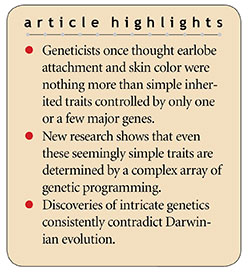Many people were told in biology class that some basic human traits reflect simple genetic principles. One example is how earlobes are attached. When I was in high school, our biology teacher told us to examine each other’s ears and see how many had attached versus unattached earlobes. Attached earlobes do not have a lobe that dangles. In general, there were many more students with unattached than attached earlobes. We were told the attached variant is an example of a classic single-gene recessive trait, an explanation that makes genetics appear overly simple.
However, some scientists have been questioning this oversimplified paradigm since well before the days of modern genomics and DNA analysis. As early as 1937, one scientist pointed out that earlobe attachment could be a multi-gene trait.1 Thanks to modern research techniques that help reveal the mysteries of the genome, we now know that even the concept of what clearly defines a single gene is blurred by unimaginable and unexpected complexity.2 A recent research report on the classic textbook idea that a single gene controls earlobe attachment has once again reached the standard conclusion of the genomics era—genetic activity appears to be far more complex than previously thought.
We now know that even the concept of what clearly defines a single gene is blurred by unimaginable and unexpected complexity. ![]()
 In this new earlobe genetics study, researchers used DNA sequencing data and earlobe measurements from 74,660 people with European, Latin American, or Chinese ancestry. By associating DNA sequences across the genome with the ear development patterns in people, the researchers identified 49 genomic regions related to the attached earlobe trait. They also sequenced the products of genes turned on during ear development, which confirmed that the many different genes they discovered in their DNA trait association study were in fact located among many different associated regions in the genome. The authors of the paper state, “These genes provide insight into the complex biology of ear development.”3
In this new earlobe genetics study, researchers used DNA sequencing data and earlobe measurements from 74,660 people with European, Latin American, or Chinese ancestry. By associating DNA sequences across the genome with the ear development patterns in people, the researchers identified 49 genomic regions related to the attached earlobe trait. They also sequenced the products of genes turned on during ear development, which confirmed that the many different genes they discovered in their DNA trait association study were in fact located among many different associated regions in the genome. The authors of the paper state, “These genes provide insight into the complex biology of ear development.”3
This study follows close on the heels of two other human genetics studies that debunk the previously held belief that skin color is controlled by only a few major genes.4,5 Both studies used human subjects from countries in Africa, the continent with the largest spectrum of skin color diversity in the world. One study found that six major genes contribute to 30% of the total variability in skin color.4 The other 70% of the genetic contribution to color variability was from numerous other genes and regions around the genome. In the second study, researchers found that 15 different genes make major contributions to skin color.5 These skin color studies fit well with the biblical narrative of how human people groups developed as a result of the dispersion at the Tower of Babel, as discussed in a recent ICR news post.6
Only an all-wise Creator could be responsible for engineering these amazing systems. ![]()
The oversimplified evolutionary paradigm does not fit well with human genome studies that consistently show ever-increasing levels of complexity. Seemingly simple traits turn out to be not simple at all due to the networked interconnectivity of genes in complex dynamic systems throughout the genome. Only an all-wise Creator could be responsible for engineering these amazing systems.
References
- Wiener, A. S. 1937. Complications in ear genetics. Journal of Heredity. 28 (12): 425-426.
- Tomkins, J. P. 2014. Gene Complexity Eludes a Simple Definition. Acts & Facts. 43 (6): 9.
- Shaffer, J. R. et al. 2017. Multiethnic GWAS Reveals Polygenic Architecture of Earlobe Attachment. The American Journal of Human Genetics. 101 (6): 913-924.
- Crawford, N. G. et al. 2017. Loci associated with skin pigmentation identified in African populations. Science. 10.1126/science.aan8433.
- Martin, A. R. et al. 2017. An Unexpectedly Complex Architecture for Skin Pigmentation in Africans. Cell. 171 (6): 1340-1353.
- Tomkins, J. P. Skin Color Research Confirms Biblical Narrative. Creation Science Update. Posted on ICR.org November 2, 2017, accessed December 4, 2017.
* Dr. Tomkins is Director of Life Sciences and earned his Ph.D. in genetics from Clemson University.




